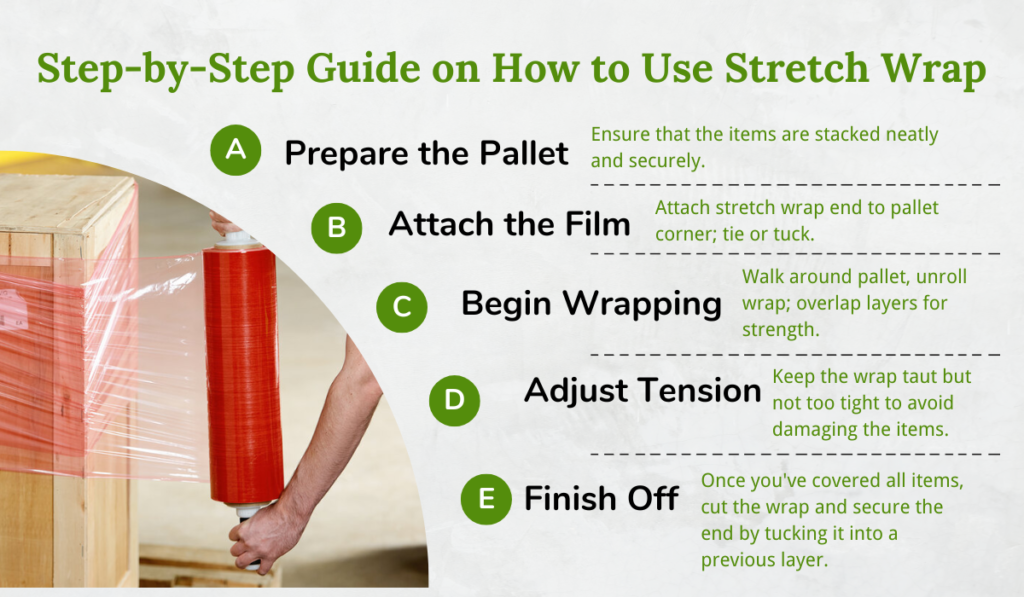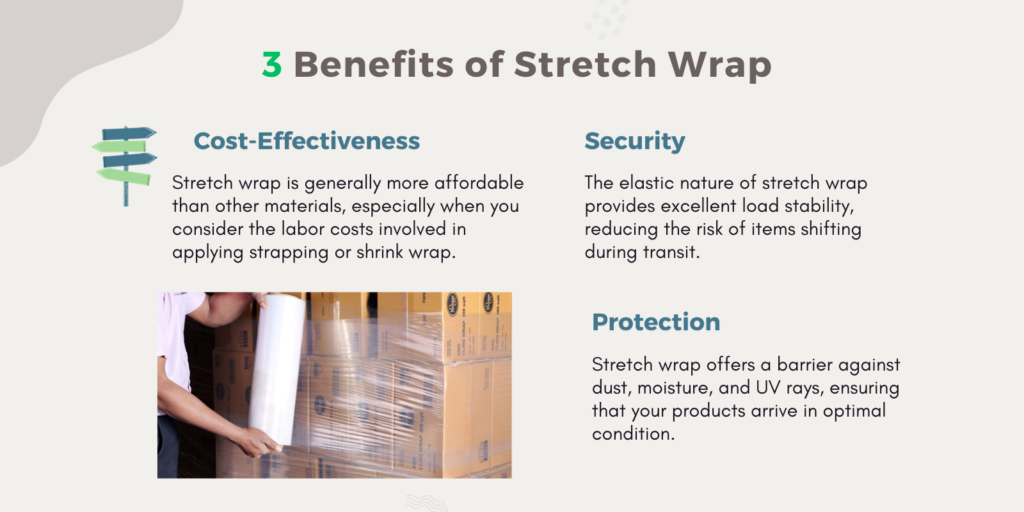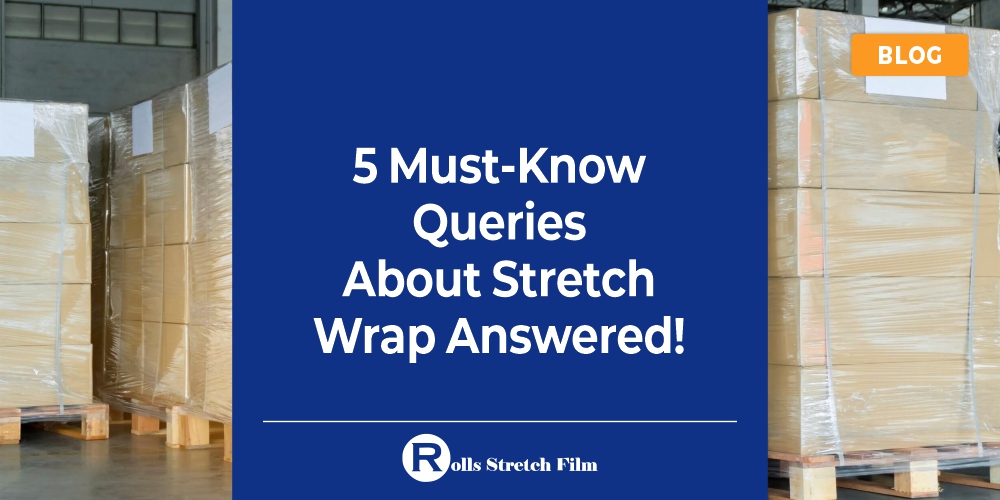Have you ever been puzzled by the various types of stretch wrap available in the market? Maybe you’re wondering how to choose the right one for your specific needs, or perhaps you’re curious about the environmental impact of using stretch wrap. These questions are common, and the answers can significantly impact your business operations and sustainability efforts.
Stretch wrap is an indispensable tool in the packaging and shipping industry. It helps secure and protect goods during transit, offering a cost-effective and reliable solution. This article addresses the five most common questions about stretch wrap, providing you with the knowledge you need to make informed decisions. So, whether you’re new to the world of stretch wrap or looking to deepen your understanding, read on for valuable insights that could save you time and money.
Question 1: What is Stretch Wrap?

Definition of Stretch Wrap
Stretch wrap, or stretch film, is a highly elastic plastic material commonly made from linear low-density polyethylene (LLDPE). It is designed to wrap around items, particularly packages, and pallets, to secure them for storage or transport. Having been in the packaging industry for years, I’ve seen firsthand how stretch wrap has evolved to meet various needs, from manual wrapping to machine-operated solutions.
Description of its Use Across Industries
Stretch wrap is not limited to a single industry; it’s a versatile material used across various sectors. From the food and beverage industry to electronics and automotive parts, stretch wrap ensures that products reach their destination in pristine condition. Its adaptability allows it to be used for both small-scale and large-scale packaging, making it a go-to solution for businesses of all sizes. I’ve consulted with companies in diverse industries, helping them optimize their use of stretch wrap for maximum efficiency and cost-effectiveness.
Importance to Shipping and Packaging Industries
In the shipping and packaging sectors, the importance of stretch wrap cannot be overstated. It is the final layer of protection for goods, safeguarding them from dust, moisture, and potential damage during transit. The material’s elasticity allows it to tightly secure items, reducing the risk of load shift—a common cause of accidents and product damage. Over the years, I’ve conducted multiple studies on packaging materials, and stretch wrap consistently proves to be a reliable choice for ensuring goods’ safe and efficient transport.
Question 2: What are the Different Types of Stretch Wrap?

Explanation of the Various Types
When it comes to stretch wrap, one size doesn’t fit all. Over the years, I’ve worked with various stretch wrap types, each designed for specific applications. The most common types are hand stretch wrap and machine stretch wrap. Additionally, there are specialized versions like pre-stretched wrap and vented pallet wrap, which cater to more specific needs.
Types of Stretch Wrap and Its Unique Characteristics
- Hand Stretch Wrap: This is ideal for smaller operations where manual wrapping is feasible. It’s user-friendly and doesn’t require any machinery. I’ve often recommended this for businesses starting out or with lid packaging needs.
- Machine Stretch Wrap: Designed for more extensive operations, this type is intended for use with wrapping machines. It’s more efficient for wrapping multiple pallets and offers consistent tension. Having set up several automated packaging lines, I can attest to the efficiency gains this type provides.
- Pre-Stretched Wrap: This is a lighter, easier-to-apply option. It’s already stretched, requiring less effort to apply, and offers excellent load stability. I’ve seen this used effectively in fast-paced environments where time is of the essence.
- Vented Pallet Wrap: This type has small holes for better airflow, making it ideal for perishable goods. This is a game-changer for maintaining product quality during transit if you’re in the food or agriculture sector.
| Type of Wrap | Description | Use Cases |
|---|---|---|
| Hand Stretch Wrap | Ideal for smaller operations where manual wrapping is feasible. User-friendly and doesn’t require any machinery. | Recommended for businesses starting out or with limited packaging needs. |
| Machine Stretch Wrap | Designed for extensive operations and intended for use with wrapping machines. Offers consistent tension. | Efficient for wrapping multiple pallets. Best for automated packaging lines. |
| Pre-Stretched Wrap | Lighter, easier-to-apply option. Already stretched, requiring less effort to apply. Offers excellent load stability. | Effective in fast-paced environments where time is crucial. |
| Vented Pallet Wrap | Has small holes for better airflow, making it ideal for perishable goods. | Essential for maintaining product quality during transit, especially in the food or agriculture sector. |
Advice on Choosing the Right Type for Specific Needs
Choosing the correct type of stretch wrap can be a bit overwhelming, but it’s crucial for optimizing your operations. Hand stretch wrap might be your best bet if you’re wrapping fewer than 15 pallets a day. Machine stretch wrap will provide the efficiency you need for more extensive procedures. Pre-stretched wrap is excellent for quick applications, while vented pallet wrap is essential for perishable goods. I’ve helped businesses make these decisions, taking into account factors like volume, product type, and shipping conditions.
Question 3: How is Stretch Wrap applied?
Step-by-Step Guide on How to Use Stretch Wrap
Using stretch wrap effectively is an art I’ve honed over years of hands-on experience. Here’s a simple guide to get you started:
- Prepare the Pallet: Ensure that the items are stacked neatly and securely.
- Attach the Film: Take the end of the stretch wrap and attach it to the corner of the pallet. You can tie it or tuck it under a box to secure it.
- Begin Wrapping: Walk around the pallet, unrolling the stretch wrap. Make sure to overlap layers for added strength.
- Adjust Tension: Keep the wrap taut but not too tight to avoid damaging the items.
- Finish Off: Once you’ve covered all items, cut the wrap and secure the end by tucking it into a previous layer.

Manual vs. Automatic Application
Manual wrapping is generally more suitable for smaller operations or irregularly shaped items. It gives you more control but can be labor-intensive. Automatic wrapping, on the other hand, is ideal for larger volumes. Machines can wrap pallets more quickly and uniformly. Having implemented both methods in various settings, I can say that the choice between manual and automatic largely depends on your specific needs and the scale of your operations.
Tips and Tricks for Efficient Application
- Corner Boards: Use corner boards for added protection and to maintain the shape of the pallet.
- Film Memory: Stretch the film slightly to activate its “memory,” which helps it cling better.
- Top Sheets: Consider using top sheets for added protection against dust and rain.
- Layering: Double wrap fragile items for extra security.
Question 4: Why is Stretch Wrap better than other Packaging Material?

Comparison Between Stretch Wrap and Other Packaging Materials
In my years of experience in the packaging industry, I’ve had the opportunity to work with a variety of materials, including shrink wrap, strapping, and packing tape. Here’s how stretch wrap compares:
- Shrink Wrap: Unlike stretch wrap, shrink wrap shrinks when heated. It’s great for bundling products but lacks the tensile strength that stretch wrap offers for heavier loads.
- Strapping: While strapping is strong, it doesn’t offer the same level of protection against moisture and dust. It’s also more time-consuming to apply.
- Packing Tape: Tape is useful for sealing boxes but isn’t designed to secure loads on a pallet. It lacks the elasticity and strength that stretch wrap provides.
| Packaging Material | Description | Pros | Cons |
|---|---|---|---|
| Shrink Wrap | Shrinks when heated. | ✅ Great for bundling products. | ❌ Lacks tensile strength for heavier loads. |
| Strapping | Strong material for bundling. | ✅ High strength. | ❌ Time-consuming; less protection against moisture/dust. |
| Packing Tape | Used for sealing boxes. | ✅ Effective for box sealing. | ❌ Not for pallet loads; lacks elasticity and strength. |
3 Benefits of Stretch Wrap
Stretch wrap offers several advantages that make it a superior choice for many applications:
- Cost-Effectiveness: Stretch wrap is generally more affordable than other materials, especially when you consider the labor costs involved in applying strapping or shrink wrap.
- Security: The elastic nature of stretch wrap provides excellent load stability, reducing the risk of items shifting during transit.
- Protection: Stretch wrap offers a barrier against dust, moisture, and UV rays, ensuring that your products arrive in optimal condition.

Versatility of Stretch Wrap in Different Applications
One of the reasons I often recommend stretch wrap to clients is its versatility. Whether you’re shipping electronics, food items, or industrial equipment, stretch wrap can be tailored to meet your specific needs. It’s compatible with various types of machinery and can be applied manually, making it a flexible solution for businesses of all sizes.
Question 5: Can Stretch Wrap be Recycled?
Overview of the Recyclability of Stretch Wrap
Yes, stretch wrap can be recycled, and this is a topic close to my heart. I’ve been involved in sustainability initiatives within the packaging industry, and I can confirm that most stretch wraps are made from recyclable materials like low-density polyethylene (LDPE). However, it’s essential to remove any contaminants like labels or adhesives before recycling.
Evaluation of Its Environmental Impact
While stretch wrap is recyclable, it’s crucial to acknowledge that not all facilities accept it. When not recycled, stretch wrap can contribute to landfill waste and environmental degradation. I’ve been part of teams that assess the environmental impact of packaging materials, and it’s clear that responsible disposal of stretch wrap is necessary for minimizing its ecological footprint.
4 Suggestions for Proper Disposal and Recycling
- Collection: Gather used stretch wrap separately from other waste to avoid contamination.
- Cleaning: Remove any labels, tapes, or other non-polyethylene materials.
- Drop-off: Take the cleaned stretch wrap to a recycling facility that accepts LDPE materials. Some businesses also have dedicated bins for stretch wrap recycling.
- Commercial Services: For larger operations, consider hiring a commercial recycling service specialized in stretch wrap.

By following these steps, you contribute to a more sustainable packaging ecosystem. I’ve consulted with organizations to implement recycling programs, and I can attest to the positive impact it has—not just on the environment but also on company morale and public image.
Conclusion
In this article, we’ve covered the essential aspects of stretch wrap, from its definition and types to its effective usage and environmental impact. With years of experience in the packaging industry, I can confidently say that stretch wrap is a versatile and reliable choice for various applications. It offers cost-effectiveness, security, and protection, making it a go-to solution for businesses big and small.
Understanding your packaging materials is not just about cost-saving; it’s also about making responsible and informed choices. Whether you’re a small business owner or a logistics manager, I hope this article equips you with the knowledge you need to make the best decisions for your operations and the environment.














